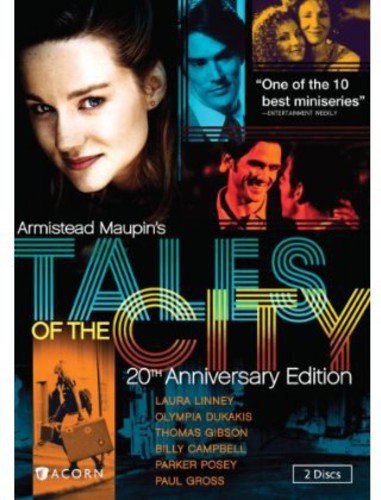
The six-part mini-series Tales of the City (1993) boasts an all-star cast, including the city of San Francisco itself. The year is 1976, and young Mary Ann Singleton (Laura Linney) has just moved to the city from the Midwest. She takes a room at 28 Barbary Lane, a boarding house run by a mysterious older woman named Mrs. Anna Madrigal (Olympia Dukakis), and her life becomes more interesting than she could have imagined. In fact, all of the tenants at 28 Barbary Lane will lead very intriguing lives over the three-month period depicted in Tales of the City.
The series was adapted from first Tales of the City novel, written by Armistead Maupin and published in 1978. Interestingly enough, this very American story was produced by the English Channel 4, and did not air in the United States until 1994 on PBS. Director Alastair Reid’s casual treatment of the sex and drug aspects of the story sparked a firestorm in the Bible Belt, but this is a marvelous series. One accolade came from Entertainment Weekly, who named Tales of the City one of the “Ten Best Mini-Series on DVD” in 2005.
Acorn have just issued Tales of the City: The 20th Anniversary Edition as a two-DVD set, and the series remain as fascinating as ever. It is a time-capsule of life in San Francisco in 1976, but outside of the music and styles, surprisingly little about the show feels dated. With gay marriage and marijuana now legal in some states, one may wonder what all the fuss was about 20 years ago. It is easy to forget how much things have changed in the US since 1993.
The story begins with Mary Ann deciding to remain in San Francisco while she is vacationing there. The friend she was staying with is a little loony, so Mary Ann looks around town for a suitable vacancy, and happens upon 28 Barbary Lane. This is a beautiful old house with an incredible view of the city. The place has been carved up into six apartments, and Mrs. Madrigal chooses her tenants very carefully. When Mary Ann moves in, she becomes part of the little bohemian community.
The lives of these characters interact in many unexpected ways. The first tenant Mary Ann meets is the raven-haired, self-described “fag hag” Mona Ramsay (Chloe Webb), who helps her land a job at one of the city’s major newspapers. While Mary Ann embarks on what proves to be a very unsatisfying affair with the publisher’s son, the publisher himself winds up having an affair with Anna Madrigal. One of the many things we eventually discover is that the “Mrs.” part of Ann’s name is a construct. She is no widow, in fact she is very, very different from what she initially appears to be.
Besides perhaps New York, San Francisco was the most hedonistic American city in the ‘70s. This was the pre-AIDS era, and the series does not shy away from showing the promiscuity of the era. Not that it is explicit; this was a television show after all. But we have a fairly good idea of what happens when these men spend all night in a bathhouse.
As uncompromising as it may have been, what makes Tales of the City so good is not the way in which such controversial topics as homosexuality and casual drug use are treated though. It is in the many mysteries of these people’s lives that continually unfold as the series progresses. Everything comes to a head on New Year’s Eve, which becomes a night nobody will ever forget.
The main bonus feature is a 36-minute segment featuring behind-the-scenes footage and rehearsals. There is also an eight-page booklet, an introduction by Armistad Maupin, notes by producer Alan Poul, and filming locations and landmarks.
While the period details of Tales of the City add a lot of color, it is the tales themselves that make this such a great mini-series. The city of San Francisco has never looked better either.